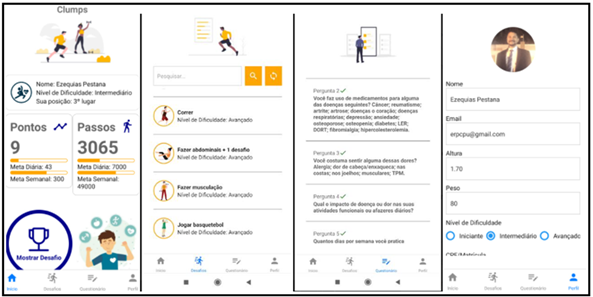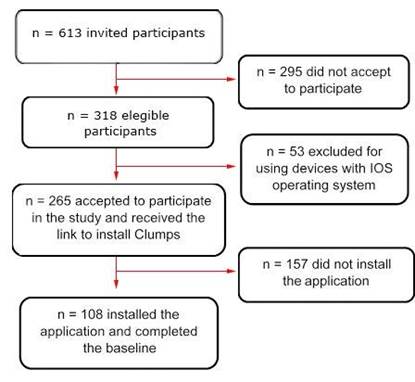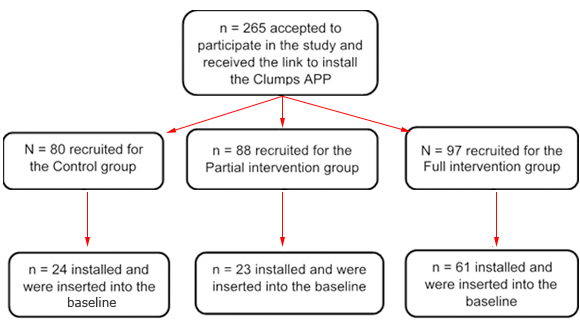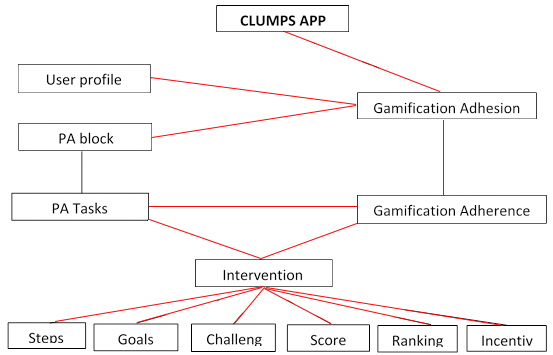Introduction
The advances in healthcare in recent decades have generated sufficient evidence, making it possible to assert that a series of behaviors considered healthy, such as the practice of physical activity, are strongly linked to the decrease in morbidity due to coronary artery disease, stroke, arterial hypertension, type 2 diabetes, obesity, and depression.1,2,3 Despite the health benefits of physical activity, adherence to physical activity programs can be challenging. Low adherence to a prescribed physical activity regimen can significantly decrease the short-and long-term benefits of such programs.
Internet access has been seen as a tool for the promotion of change in health behavior. In March 2021, about 65.6% of the world's population had access to the Internet, which corresponds to 5.1 billion people, a growth of 1,331.9% between the years of 2000 and 2021.4 In this sense, advances in health technology are creating opportunities for users to actively engage in self-care in various ways, stimulating the change in health behavior,5,6 and new digital mobile technologies are also part of this scenario, where activated mobile phones (smartphones) outnumber citizens,7 with approximately 63% of the adult population owning at least one smartphone in 2017.8
Smartphones offer advanced global positioning technology features as well as built-in accelerometers and offer the ability to create individualized and interactive applications that collect data in real-time.9 In addition, Middelweerd and others10) highlight the importance of the fact that people are always carrying their smartphones and accessing information from anywhere and at any time, and these applications that aim to promote healthy behaviors could promote individualized information and advice at the most appropriate times. In this same direction, Dennison and others11 cite the incentives, interaction mechanisms, and alerts as important features of these applications.
Smartphone applications are promising tools to provide accessible and engaging interventions for various components of a healthy lifestyle and are being recognized as a potential approach to increase adherence to better lifestyle guidelines7 and gamification-based stimuli are able to stimulate commitment and provoke changes in people's behavior, making the change in their actions and the broadening of their commitment possible.12 Defined as the use of game elements in non-game contexts, gamification is a promising way to capitalize on the effectiveness of digital interventions and integrate gaming techniques into interventions, making it possible to motivate and engage users.13
A systematic review and meta-analysis was conducted by Romeo and others14 to analyze the use of smartphones to increase physical activity practice. The authors identified that the application-based physical activity interventions have a positive and non-significant influence. Although there is evidence that smartphone apps have a positive effect on physical activity when used for a short-term period in which they target only physical activity rather than physical activity in combination with other health behaviors.
The results of this study, however, suggest that gamified resources and interventions may attenuate physical inactivity due to a change in step behavior and a positive correlation between points and steps. In this sense, a very recent systematic review and meta-analysis analyzed in 16 articles the effect of gamified intervention compared to non-gamified in several populations (adolescents, healthy adults, adults with comorbidities) and concluded that gamified interventions seem to be a promising way to increase the number of steps daily and promote physical activity (PA) in several populations15 and own gaming techniques can add elements of fun to encourage greater engagement with the app.16
Therefore, there is an open space for these mobile technological advances to contribute to the promotion of physical activity, as well as to identify factors associated with physical inactivity and more attractive engagement resources.17
CLUMPS displays multiple screens through its interface, offers distinct interventions, and collects data from the sensors that are integrated into the smartphone. Based on this scenario, this article aims to describe the theoretical foundation and the development process of CLUMPS, a smartphone application with the objective of promoting physical activity with the use of gamification elements in its development proposal.
Methods
This article is a description of the theoretical and methodological bases for the development of a mobile application named CLUMPS - Clube Mover Pela Saúde. Its development process was conducted with the support of the Laboratory of Research and Epidemiological Studies in Physical Activity, Exercise, Sport and Health (LAPAES), linked to the Physical Education course of the Federal University of Maranhão, São Luís-MA Campus.
The application was conceived by the authors of this article and programmed by a technical professional hired with the researchers' own resources. After the initial planning phases, periodic meetings and initial testing, a randomized controlled pilot clinical trial was initiated and conducted between December 2021 and January 2022 with academics linked to CEUMA University, Renascença Campus, in São Luís-MA, Brazil. The study was approved by the CEUMA University's Ethics and Research Committee (Number: 5.149.569).
CLUMPS - Origin and gamified profile
CLUMPS was conceived as a collection instrument and aggregating tool of interventions at the behavioral level. It is described as a mobile application that emerged as a natural evolution of another project of our group, which developed an online questionnaire on lifestyle and physical activity that makes use of gamification18 having the smartphones as its main interface and also being able to gather characteristics from social media: interpersonal and network interaction, content sharing and production by the users themselves, challenges, playfulness, and customization.19,20
By integrating gamified mechanisms into interventions, it enables the use of various proprietary techniques that make tasks enjoyable to motivate participants to engage and the relationship between people's motivation and self-efficacy, social approval and mastery allows the use of rewards, competition and attention to undertake challenges and achieve goals.21
Thus, the use of gamification concepts as strategies for the development of CLUMPS can encourage adhesion and adherence in promoting and increasing users' physical activity.
Definition of variables
The proportion of individuals who achieved sufficient level of physical activity in leisure, according to current WHO guidelines (between 150 and 300 minutes per week) at the end of the study will be compared with the baseline ratio.
The number of steps taken and the association for the compliance with recommendations (beginners = 4500 daily steps, intermediate = 7000 daily steps, and advanced = 10000 daily steps) for the promotion of health, as well as achieving more than 10000 daily steps.
The points reached by the app according to the three difficulty levels of the activities (beginners = 150 points, intermediate = 300 points, and advanced = 450 points), both weekly.
Primary outcomes
The main results of the study will be evaluated by the counting of steps and points. The score will be estimated through the challenges proposed by the CLUMPS application. For all intra-and inter-group effects, the main comparative associations will be investigated. The statistical models will analyze the steps and intervention components of each group (control, partial intervention, and full intervention) involved in the study, during the study period.
Secondary outcomes
The secondary analysis of the study addresses the identification of the physical activity profile of the participants, the challenges and difficulty levels of the most used activities, and the participant's self-efficacy in achieving the goals through the application resources.
Recruitment
Of the 613 academics invited to participate in the study, 295 did not accept to participate in the study, 318 were classified as eligible, 53 were excluded for using devices with IOS operating system, 265 received the link to install the CLUMPS app, 157 did not install, and 108 participants installed the CLUMPS app and completed the baseline of the study, according to the flow of sample participants (fig.1).
Of the 265 participants eligible to receive and install the CLUMPS app link, n = 80 (30.5%) integrated the control group, n = 88 (33.6%) integrated the partial version, and n = 94 (35.9%) integrated the full version of CLUMPS. Out of these, 24 participants installed the control version, 23 participants installed the partial version, and 61 participants installed the full version of CLUMPS (fig. 2).
Basic Characteristics
Participants were aged between 18 and 50 years with a mean of 25.62 ± 7.47 years. Out of these, a homogeneous sample, n = 54 (50%) are women and n = 54 (50%) are men. When stratified by study group, the ratio and sex (GIG: 33 men x 28 women, PIG: 10 men x 13 women, and CG 11 men x 13 women) shows almost homogeneity.
Initial data on the self-reported level of difficulty of physical activity of the 108 participants indicate: 93 (86%) reported to be beginners (perform activity with mild degree of difficulty), 13 (12.2%) reported to be intermediate (perform activity with moderate degree of difficulty) and 2 (1.8%) reported to be advanced (perform activity with high degree of difficulty).
Statistical analysis
We have presented descriptive baseline data (from recruitment to eligibility, average age, overall gender, gender by-study-group, proportion, and PA difficulty level profile) of participants. In addition, we have highlighted the initial counting data of steps and points. Finally, we have presented other variables inserted in the sample baseline. The SPSS 23.0 program was used for descriptive data analysis.
Results
The CLUMPS was designed to be the main tool both for intervention through challenges, counseling, and online social interactions; as well as for data collection through the answers to the questionnaires included in the application, time of use, interactions, among others as shown (fig. 3).
CLUMPS intervention components
Clube Mover pela Saúde - CLUMPS application uses and displays various tools to provide greater engagement and achievement of goals to users. Therefore, it has features such as: I) user profile; II) results measure; III) score; IV) goals; V) physical activities measure; VI) physical activity challenge route; VII) physical activity incentives and VIII) ranking. In this sense, CLUMPS registers, evaluates, classifies, displays, monitors, encourages, and proposes a challenge, goals, and ranking roulette in an integrated and gamified way (fig. 4).

Fig. 4 Main screens (initial view, challenges, PA questionnaire and participant profile, respectively) of CLUMPS.
The features displayed by the application are introduced below:
I-User profile
CLUMPS requests information such as name, CPF (individual taxpayer identification number), phone, date of birth, gender, marital status, number of children, years of study, self-reported level of difficulty of the physical activity (beginner, Intermediate, and advanced), as well as weight and height (to estimate body mass index - BMI).
II-Measures of outcome
CLUMPS displays objective and subjective measurement through the counting of physical activity steps and points, respectively. The steps are displayed through an interaction with GoogleFit, a health tracking platform developed by Google.22 The score count is a tool of the application itself and is calculated through the duration and level of difficulty of the physical activity challenges performed by the user.
III-Score
The Scoring is a mechanism that allows the participant to be inserted into a ranking, through two classifications: the activity's level of difficulty (easy, medium, and difficult) and the number of tasks performed (daily, weekly, and monthly), to generate a score assigned to the task. Each CLUMPS' challenge performed by the user generates a score that is related to the effort that the task requires. Thus, light effort activities (≅1.5 - 3 METs), moderate effort activities (≅3 - 6 METs), and high-intensity activities (≅> 6 METs), generate 1 point per minute, 2 points per minute, and 3 points per minute, respectively. Therefore, each proposed intervention has a specific score according to its difficulty and calorie expenditure established by the International Compendium of Physical Activities.23
IV-Goals
The proposed CLUMPS goals follow the World Health Organization recommendations according to the requirements and fulfillment of the tasks (level of difficulty and number of tasks performed) associated with the self-reported level of physical activity by the participant. For each level, goals of movement points and steps taken are set as follows:
Beginner: 150 movement points and 4000 daily steps.
Intermediate: 300 movement points and 7000 daily steps.
Advanced: 450 movement points and 10000 daily steps.
The steps goals were based on the study by Saint-Maurice and others24 which associated the number of steps with lower mortality by all causes. The points targets are in line with current WHO recommendations.
V-Measurement of physical activity
The MAFIS physical activity questionnaire measures physical activity subjectively. The questionnaire was validated (publication process) according to the protocols of movement counts over an epoch time interval 25) and the Baecke questionnaire on the level of regular physical activity, validated through a sample of Brazilian adults26. For the physical activity's classification level, a score based on the recommendations proposed by the World Health Organization of 150 minutes per week was used27.
VI-Physical activity challenges (CLUMPS challenges)
The app displays a variety of physical activities called CLUMPS challenges, characterized through a random roulette built into the app, and aimed at increasing the practice of physical activity. The challenges are based on the International Compendium of Physical Activities,23 according to the abilities of the activity, metabolic equivalent of the task (METs), and intensity levels, described in table 1.
Table 1 Physical activities, abilities, and metabolic equivalents of the task - CLUMPS
| Physical Activity Expertise | Mild Intensity | METs | Physical Activity Expertise | Moderate intensity | METs | Physical Activity Expertise | High intensity | METs |
|---|---|---|---|---|---|---|---|---|
| Leisure | stretch | 1.5 - 3 | Leisure | do push-ups | >3 and < 6 | Leisure | do push-ups + 1 challenge | > 6 |
| Leisure | dance | 1.5 - 3 | Leisure | do crunches | > 3 and < 6 | Leisure | Run | > 6 |
| Leisure | bowling | 1.5 - 3 | Leisure | do jumping jacks | > 3 and < 6 | Leisure | do crunches + 1 challenge | > 6 |
| Leisure | walk | 1.5 - 3 | Leisure | aerobic dance | > 3 and < 6 | Leisure | CrossFit | > 6 |
| Leisure | walk with your pet | 1.5 - 3 | Leisure | bike | > 3 and < 6 | Leisure | do jumping jacks + 1 challenge | > 6 |
| Leisure | surf | 1.5 - 3 | Leisure | play racquetball | > 3 and < 6 | Leisure | Jump rope + 1 challenge | > 6 |
| Work | walk during work | 1.5 - 3 | Leisure | play badminton | > 3 and < 6 | Leisure | weightlifting | > 6 |
| Domestic | caring for the house or garden | 1.5 - 3 | Leisure | gymnastics | >3 and < 6 | Leisure | play soccer | > 6 |
| Domestic | make general and house repairs | 1.5 - 3 | Leisure | skateboarding | > 3 and <6 | Leisure | play basketball | > 6 |
| leisure | play tennis | > 3 and < 6 | Leisure | play futsal | > 6 | |||
| Leisure | hiking | > 3 and < 6 | Leisure | play volleyball | > 6 | |||
| Work | go up and down stairs | > 3 and < 6 | Leisure | play handball | > 6 | |||
| Transportation | walk to work | > 3 and < 6 | Leisure | swim | > 6 | |||
| Transportation | walk to school or college | >3 and < 6 |
Source: Elaboration of the authors.
CLUMPS functions as a challenge roulette, randomizing daily and weekly tasks to encourage the goals to be achieved. But the user can choose whether to perform the proposed activity or draw another one, as well as choose an activity or set it as a daily challenge. The physical activities (CLUMPS challenges) are displayed according to the level of difficulty of the activity reported by the user and are composed as follows: (for those who report being beginners at physical activity = 70% light level activity, 20% moderate level, and 10% intense level; for those who report being intermediate at physical activity = 10% light level, 70% moderate level and 20% intense level; for those who report being advanced at physical activity = 10% light level, 20% moderate level, and 70% intense level).
VII-Physical activity incentives
To perform or increase physical activity practice, CLUMPS sends motivational messages such as: 1 - Take care of your health and earn more points, start your challenge right away! 2-Congratulations, you have reached your daily or weekly steps and/or points goal. Therefore, CLUMPS displays motivational information, as well as messages at every two hours between 6 am and 11 pm, right after the achievement of goals, congratulating the participant on the task performed.
VIII-Ranking
CLUMPS monitors and displays all activities performed (steps, points, and challenges completed) by the user. As a mechanism for gamification and behavioral stimulation, CLUMPS have an icon on the main screen that informs the position of the participant compared to others involved in the study.
Finally, we emphasize that no applications have been identified documented in literature that would display a random challenge roulette functionality (for activities and exercises) as a strategy to promote and/or increase the practice of physical activities; that would contemplate the four domains (leisure, transportation, work or academic-related, and domestic) of physical activity and that would use a random ranking to provide adhesion and adherence to the practice of physical activity, according to the participant's profile.
Theoretical basis of the intervention
Knight and others28 highlight that social resources in physical activity applications can assist users in engaging with health-related behaviors, considering then that their inclusion improves the usefulness of application. For them, this is due to information sharing, connection with other practitioners, access to other social networks, and the possibility of posting the workouts.
In another way, Cognitive Social Theory (CST) has as its premise that human behavior is the result of the reciprocal and dynamic interaction of personal factors and the social environment29 and this is used in the development of effective and long-lasting interventions to increase PA. Thus, CST served as a theoretical framework for the formulation of interventions, based on 5 constructs: behavioral capacity, social support, self-efficacy, result expectations, and self-regulation. Table 2 shows a brief description of the components used in the proposed intervention to increase physical activity.
Table 2 Components of cognitive social theory
| Behavioral ability | The CLUMPS sends messages and challenges for the understanding, execution and ability to perform physical activity, such as: definitions of physical activity and exercise; different types of PA (leisure, commuting, work or academic and domestic); physical activity recommendations and goals to achieve the guidelines; how to determine the intensity of the performed physical activity. |
| Social Support | CLUMPS provides interaction resources among participants to encourage and influence the achievement of tasks and goals in the performance of physical activities. |
| Self-efficacy | CLUMPS provides participants to track PA using the intervention-encouraged physical activity tracking feature and track their increases or decreases in physical activity (ie, mastery experiences) to gain confidence in themselves to take action and overcome barriers. |
| Expectation of results | CLUMPS displays the monitoring of participants' physical activities, to guide them towards meeting goals and challenges, as well as their completion. |
| Self-regulation | Ability to manage social, cognitive and motivational processes to achieve a desired goal. CLUMPS provides self-monitoring capability for daily, weekly, and monthly physical activity. |
Source: Elaboration of the authors.
Discussion
In this article, we describe the development process, the theoretical bases and the initial tests of a mobile application designed to function as a mechanism for recording physical activity and intervention in user behavior based on gamification components. Thus, we present a theoretical-descriptive model that supported the development of this tool that seeks to preliminarily investigate the effectiveness of CLUMPS. Such features allow the prediction of a greater engagement of the participants in the promotion of physical activity, highlighting the interaction of the user with the intervention components displayed by the application.
Thus, previous research used the Social Cognitive Theory,30,31,16,32 similar to the present study, as a reference for the formulation of interventions. In addition, studies have used gamified, web-based stimuli with adolescents,33 healthy adults,34 adults with obesity35 and based on in a smartphone app, with inactive adults,16 university students,36 office workers,32 patients with diabetes37 with the aim of promoting or improving the practice of physical activity.
Therefore, methodologies based on gamification and the use of Social Cognitive Theory are widely used in the development of smartphone applications and are presented as a strong ally in mitigating inactivity and promoting physical activity in different populations.15
Therefore, CLUMPS allows recording, evaluating and analyzing, in addition to the number of steps, other components of physical activity, such as: the efficiency of the intervention set, correlating the score to the steps, the engagement of the participants, the levels of activity challenges and it even allows observing the effectiveness of this type of intervention in the temporal aspect in the future. This set of information will allow a greater depth of research and the impacts of this type of intervention.
Conclusion
The methodological strategies of gamified stimuli included in the development of the CLUMPS application can promote and increase the practice of physical activity among users.
Limitations and strengths of the study
The first and strongest limitation evidences the initial construction model of the application. The instrument was developed with the programming package React Native, which in theory works on devices with both Android and IOS operating systems. However, due to technical and financial limitations, the instrument can't be used in IOS devices yet. Another limitation, from a technical point of view is the step count. The CLUMPS app, in its current version, needs to be connected to the Google Fit app. Thus, the update in the step count is only done when there is access to the internet, which can cause a time lapse in this metric, apart from the need of two applications with similar functions, which may not be attractive to users. However, such limitations were expected within the development process of the application as an instrument, and it was essential to identify them during the pilot test so that we could minimize or solve such failures completely.
After the pilot results, all technological limitations encountered will be listed and presented to the professional programmer hired so that they can be solved without compromising the next phases of the application testing and the studies planned for efficiency and effectiveness assessment, being the change of the programming language one of the solutions already placed.
On the other hand, gamified interventions have great potential on the change of behavior for physical activity. In this sense, CLUMPS shows incentive to PA in other contexts in addition to leisure (mobility, work, and domestic) in different intensities, including milder; it offers support for the flexibility in relation to the moment of achieving the goals, as well as in as many moments as necessary, and it offers the possibility of scheduling the challenge. Such strategies are about giving the user autonomy and flexibility, adapting CLUMPS to their routine and PA characteristics.


















